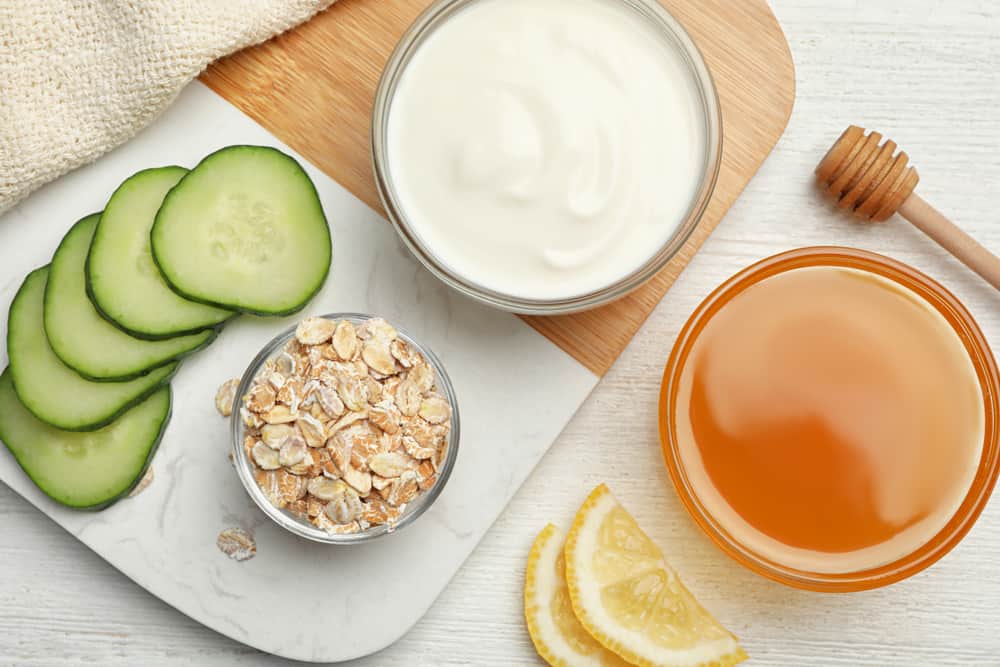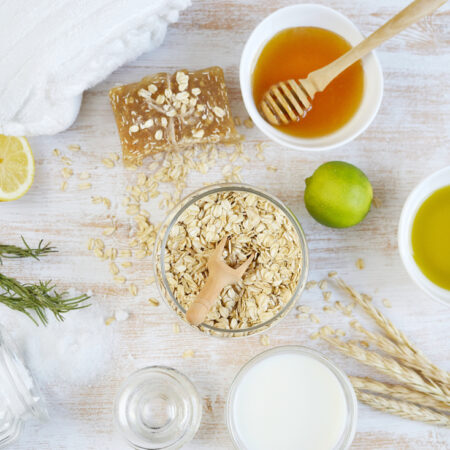Our skin takes on a lot of stress and pressure each day. It can dry out from water and wind, get too oily, and some people have irritating skin conditions, such as eczema, that can be uncomfortable or debilitating to live with.
Our skin needs to be treated with kindness and properly cared for, and one of the best ways to do that is to make an oatmeal face mask at home. Children are always told not to play with food, but smearing oatmeal and other nourishing ingredients all over your face can rejuvenate and revitalize your skin.
DIY oatmeal face masks can be made with almost any ingredient that’s safe and beneficial to the skin. We’ll walk you through how to make a mask and what to put in it to help your specific skincare needs.
What’s an Oatmeal Mask For?
Oatmeal face masks may seem like a gimmicky skincare trend, but it’s actually a beneficial form of self-care that will help heal and relieve your skin. Some use these masks to hydrate and soften dry or mature skin, remove excess oil, or bring much-needed relief to painful sunburns or eczema.
You can find oatmeal masks in the beauty aisles of drugstores or in beauty stores that sell makeup and skincare products. Unfortunately, some brands may include unnecessary chemicals that may irritate or dry out your skin.
Making these masks yourself is incredibly simple and cost-effective. Most ingredients may already be in your home, and you can easily pick them up on your next trip to the grocery store if needed.
The best part? You’re in control of the ingredients. There aren’t any surprises when you DIY, so you can easily avoid things that might upset your skin.
How to Make a DIY Oatmeal Face Mask
All oatmeal masks start the same way (with oatmeal, of course), but once you start adding other ingredients, no two masks are quite the same. Every mixture serves specific purposes. When you make it yourself, you get to tailor it to your specific needs.
Start With a Base
Almost any kind of plain oats will work. You can use whole, steel-cut, rolled (old-fashioned), and even microwavable oats that come in a package. Whichever kind you use should be the following:
- Only oats – no flavors or other ingredients
- Free of preservatives and other additives
- Organic (highly recommended, but not required)
For one mask, you’ll need about ¼ cup of ground oats or ½ cup of whole oats. Mix with equal parts water and cook according to package directions. This will create a thick paste, but you can add more water if you’d prefer it to be thinner.
You can choose to cook the oatmeal with milk if you’d prefer. Milk contains lactic acid, which is commonly used in skincare products. It may help remove dead skin and promote cell growth. Other than that, milk isn’t officially a good skincare ingredient because it lacks sufficient studies that prove or disprove its effectiveness.
Pick Your Purpose
You can’t make an oatmeal mask without choosing what you want to treat. Every ingredient has a purpose, so you should choose beforehand. Common problems oatmeal face masks can treat include:
- Acne relief
- Blemish removal
- Dry skin
- Exfoliation
- Improve complexion
- Inflamed skin
- Irritated skin
- Mature skin (anti-aging)
- Oily skin
- Reduce swelling and scars
- Reverse sun damage
Choose Your Mix-Ins
Picking oatmeal face mask mix-ins is just like picking fro-yo toppings: there are a ton of options, and the wrong choices will fill you with regret. Okay, maybe it’s not that dramatic, but it is possible to cause your skin to dry out or become oilier if you don’t pick the right stuff or use them too frequently.
We recommend about ½ teaspoon of each ingredient per mask based on the oatmeal measurements given above. Feel free to add more or less based on the consistency or your comfort level as you test out different combinations.
We list ingredients based on purposes below.
If you don’t have time to figure out what will work best for you, this video has four simple recipes: for oily or acne-prone skin, for sensitive or irritated skin, for dry skin, or for scars and anti-aging.
Apply and Wait
Use your hands to apply the mask to your face, making sure to avoid your eyes. You may find that whole oats are harder to apply than ground oats, but try to apply them the best you can.
Wait 10-20 minutes before removing the mask. To remove, rinse off with warm water and pat dry.
If you feel any kind of irritation while the mask is on, rinse it off immediately. You may have chosen an ingredient that’s inappropriate for your skin type (for example, lemon juice burns dry skin), or you may have an allergy you didn’t know about.

Find the Ingredients That Fit Your Needs
Let’s take a look at some ingredients that work well in an oatmeal face mask. Not every ingredient has to be used in every mask; treat this as a list of options rather than a complete grocery list. Most face mask recipes only have 2-5 ingredients (including oatmeal).
We recommend choosing organic ingredients that are free of additives and preservatives. Whole, natural ingredients won’t have any contaminants and are less likely to irritate your skin.
DIY masks are entirely customizable, so avoid anything you’re allergic to or don’t want to use.
Acne Relief
Recommended ingredients: almond oil, aloe vera, apple cider vinegar, avocado, banana, bentonite clay, coconut oil, cucumber, green tea, honey, tea tree oil, turmeric, witch hazel, yogurt
These ingredients have anti-microbial qualities that can kill bacteria that cause acne. These ingredients may not zap acne right away, but you should notice reduced swelling and redness almost immediately.
Dry Skin
Recommended ingredients: almond oil, aloe vera, avocado, banana, coconut oil, cucumber, green tea, red clay, shea butter, tea tree oil, yogurt
These ingredients can hydrate and soothe dry or rough skin. Be careful with red clay – using it for too long or too often will be counterproductive by drying out your skin. Only use it for 10 minutes once a week.
Exfoliation
Recommended ingredients: apple cider vinegar, honey
The acidity of apple cider vinegar exfoliates dry skin. Honey is a natural exfoliant (ever noticed that grainy feeling it has?), and raw honey is the most effective.
Improve Complexion
Recommended ingredients: avocado, honey, lemon juice, rose water, yogurt
If your skin tone appears uneven, these ingredients can level you out. Avocado and yogurt will even it out, honey and lemon juice can lighten dark spots, and rose water can reduce redness.
Inflamed Skin
Recommended ingredients: almond oil, apple cider vinegar, banana, coconut oil, green tea, lemon juice, shea butter, tea tree oil, turmeric, witch hazel
These ingredients are naturally anti-inflammatory, meaning they can reduce inflammation. Signs of inflammation are usually redness, swelling, pain, and heat. On your face, you may have inflammation near acne or a sore.
Never put anything on an open wound unless you’re instructed to do so by a doctor.
Irritated Skin
Recommended ingredients: aloe vera, avocado, bentonite clay, coconut oil, cucumber, honey, rose water, tea tree oil, turmeric, witch hazel
Skin irritation may be caused by a variety of factors including dryness, eczema, psoriasis, itching, and other skin issues. These ingredients can bring temporary relief to flare-ups. Bentonite clay can be used to relieve itching from poison oak and poison ivy.
Be super cautious and avoid putting ingredients on open wounds. If you have a severe skin condition, talk to your doctor about which ingredients are safe to use.
Mature Skin (& Anti-Aging)
Recommended ingredients: apple cider vinegar, avocado, banana, cucumber, green tea, lemon juice, rose water, shea butter, yogurt
Smooth, firm skin doesn’t last forever. Whether you’re older and want to keep your skin youthful or you want to prevent wrinkles, these ingredients will help improve elasticity and help keep your skin smooth.
Oily Skin
Recommended ingredients: bentonite clay, lemon juice, tea tree oil
If you have oily skin, you need to use ingredients that will absorb excess moisture. These ingredients will do just that. But don’t get carried away – using them for too long or too often may cause excessive dryness.
Reduce Swelling and Scars
Recommended ingredients: almond oil, banana, coconut oil, cucumber, honey, lemon juice, rose water, tea tree oil, turmeric
If you have acne scars or other scratches, these ingredients will aid in healing them. Bananas can help reduce sun spots and tea tree oil is known for healing cuts, wounds, and infections. Coconut oil may help with wound healing, but the limited research doesn’t entirely prove that claim.
Reverse Sun Damage
Recommended ingredients: almond oil, aloe vera, apple cider vinegar
Aloe vera is a well-known home remedy for soothing sunburns. Almond oil also has similar soothing effects. It’s said that apple cider vinegar may also help, but there’s not yet proof for this claim. Pair these ingredients with others that will help with dry skin, and your sunburn should feel soothed in no time.
DIY Safety Tips
All-natural and organic doesn’t automatically mean it’s safe for the skin. Consuming food and applying it to your skin are totally different experiences for your body. Follow these tips to stay safe.
Talk to a Doctor if You Have Skin Conditions or Allergies
If you have a condition that can be irritated or worsened when your skin is exposed to certain ingredients, talk to your doctor to make sure that the ingredients you want to use are safe. If you have a latex allergy, avocados and bananas can trigger it.
Never Use Essential Oils by Themselves
Essential oils, such as tea tree oil, should always be used with a carrier oil and never used by themselves because they are skin irritants. A good ratio of essential oil to carrier oil is 1:12 drops.
Wear the Mask for 10-20 Minutes
If you use ingredients that can dry you out, such as clay or lemon juice, don’t wear it for longer than 10 minutes.
Wash off the Mask if It Irritates Your Skin
Skin problems will worsen if you allow irritants to remain on your skin.
Final Thoughts
DIY oatmeal face masks are highly customizable, so you’ll be able to create exactly what you need. A homemade face mask can be as simple as oatmeal and honey and can be made in five minutes.
They’re a super easy way to add some self-care into your day.
